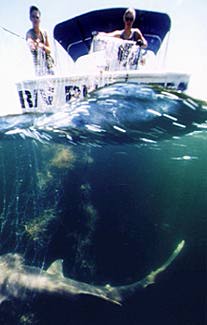
Overview
Introduction
to Sharks
Tagging and Migration
What Does Tagging Have To Do With Migration?
How Are Sharks Tagged?
Latitude and Longitude: Recording and Reporting Locations
Workbook
Activities
for Classroom
Shark Tagging Learning Activity
What Does Tagging Have To Do With Migration?
 Tagging has been especially important in studies of animal migration. Much of
what we know about animal behavior in the wild including migration patterns is
due to the fact that scientists have developed methods for tracking animals from
one remote location to another. Tagging is one of the most useful of these
methods. It helps scientists to study animals over time and to create hypotheses
based on their behavior. Where do animals go at different times of the year?
How far and how fast do they travel? Are they "residents" living in one
particular area, or "nomads," wandering great distances in search of food? These
are some of the mysteries tagging helps to solve. Animals are first captured,
then scientists or well-trained volunteers record the exact date, location, and
basic biological information. The biological information includes species, sex,
size, age, reproductive status, method of capture, stomach contents, etc. The
animal is then tagged and released until it is re-captured in another location at
a later date. Information is collected and sent back to the original institution
responsible for the tagging. From studying this data scientists can create and
test hypotheses about an animals' rate of growth, travel patterns, age, food
sources, and more. They are also able to describe the behavior of whole groups
of animals, such as identifying pupping grounds or shark nurseries where large
numbers of sharks migrate to give birth. Sharks are some of the most mysterious
of all animals and tagging is the primary method by which we understand their
migration. Because sharks travel such enormous distances beneath the surface of
the ocean, there is still a great deal to be learned about their migratory
patterns. Scientists are studying where, when, how and why sharks migrate, as
well as what factors help or hinder their migration. Like most animals, sharks
seem to migrate in search of plentiful food or to special locations to breed.
Some, such as the blue shark, have been tracked for thousands of miles, yet very
little is known about them. Others, like the nurse shark, travel relatively
short distances and seem not to migrate at all. In unique cases, like the bull
shark, sharks even migrate from salt to fresh water in search of food.
Tagging has been especially important in studies of animal migration. Much of
what we know about animal behavior in the wild including migration patterns is
due to the fact that scientists have developed methods for tracking animals from
one remote location to another. Tagging is one of the most useful of these
methods. It helps scientists to study animals over time and to create hypotheses
based on their behavior. Where do animals go at different times of the year?
How far and how fast do they travel? Are they "residents" living in one
particular area, or "nomads," wandering great distances in search of food? These
are some of the mysteries tagging helps to solve. Animals are first captured,
then scientists or well-trained volunteers record the exact date, location, and
basic biological information. The biological information includes species, sex,
size, age, reproductive status, method of capture, stomach contents, etc. The
animal is then tagged and released until it is re-captured in another location at
a later date. Information is collected and sent back to the original institution
responsible for the tagging. From studying this data scientists can create and
test hypotheses about an animals' rate of growth, travel patterns, age, food
sources, and more. They are also able to describe the behavior of whole groups
of animals, such as identifying pupping grounds or shark nurseries where large
numbers of sharks migrate to give birth. Sharks are some of the most mysterious
of all animals and tagging is the primary method by which we understand their
migration. Because sharks travel such enormous distances beneath the surface of
the ocean, there is still a great deal to be learned about their migratory
patterns. Scientists are studying where, when, how and why sharks migrate, as
well as what factors help or hinder their migration. Like most animals, sharks
seem to migrate in search of plentiful food or to special locations to breed.
Some, such as the blue shark, have been tracked for thousands of miles, yet very
little is known about them. Others, like the nurse shark, travel relatively
short distances and seem not to migrate at all. In unique cases, like the bull
shark, sharks even migrate from salt to fresh water in search of food.
Copyright © Ocean Of Know